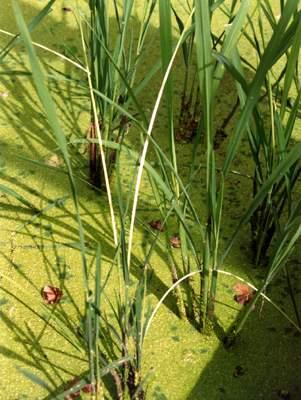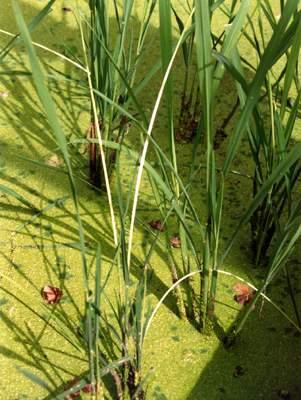

African gall midge (Orseolia oryzivora)
It is a small reddish-brown midge (similar to a mosquito) 4 to 5 mm long. Females lay up to 300 eggs on rice leaf sheaths. Upon hatching, the small maggots wiggle down to the leaf blade and move between the leaf sheath and the stem until the growing points where they feed for 2 to 3 weeks. Larval feeding induces development of light swellings or galls, which are inconspicuous until larvae are ready to pupate. The galls are long cylindrical, about 3 mm in diameter and from a few cm up to 1 to 1.5 m long. They are often silvery white and resemble an onion leaf, hence they are generally known as 'silver shoots' or 'onion leaf galls'.
Galls generally appear about 20 to 40 days after the crop has been transplanted. Gall midges can cause serious damage from the seedling stage to panicle initiation. Attacked tillers do not produce panicles. Galled plants may tiller profusely to compensate for loss of growing points. A serious attack results in stunted plant growth and poor yields. Gall midges do not attack rice plants that have matured beyond tillering stage. These midges spent some generations on wild grasses and then move to attack young rice plants. They are pests during the rainy season, and are most serious on rain-fed lowland and irrigated rice.
- Destroy alternative host plants such as rice ratoon crop, volunteers and wild red rice or longstamen rice (Oryza longistaminata).
- Destroy stubble after harvest.
- Plant resistant and early maturing varieties. Varieties tolerant to the rice gall midge released in West Africa include "Cisadane", "BW 348-1" and "Leizhung". "NERICA L-25" was found to be moderately resistant to this pest in Nigeria. The Oryza sativa japonica sub-species "TOS 14519" has shown moderately resistant to the gall midge across West Africa (WARDA). Embark on early and synchronised planting. Rice fields planted early are less likely to suffer serious damage than those planted late.
- Avoid close spacing since it provides a suitable micro-environment for the survival of this pest.
- Conserve natural enemies. Parasitic wasps (Aprostocetus procerae and Platygaster diplosisae) are very important in the natural control of the African rice gall midge. These wasps provided an important check to pest populations, especially late in the season. However, the wasp populations usually build up too late to prevent heavy gall midge infestation.
- Habitat manipulation such as dry-season cultivation to encourage Paspalum grass (Paspalum scrobiculatum) abundance early in the wet season is suggested as a way of improving the natural biological control of the rice gall midge. Paspalum grass is attacked by a different gall midge, which does not attack rice but is an alternative host for the parasitic wasps. The carry-over of parasitic wasps from gall midges attacking Paspalum grass to the rice field early in the season, could improve the natural control of the rice gall midge. The combination of growing gall midge tolerant varieties with Paspalum grass management at the edge of rice fields had significantly increased farmers' yields (WARDA).
